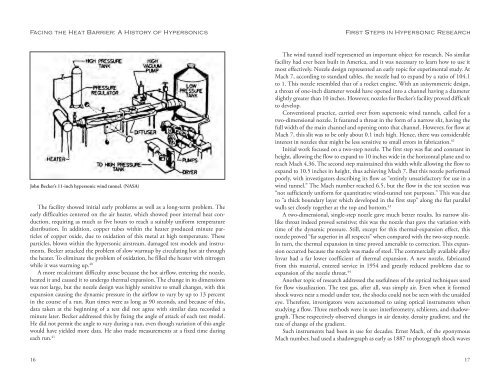Facing the Heat Barrier - NASA's History Office
Facing the Heat Barrier - NASA's History Office
Facing the Heat Barrier - NASA's History Office
You also want an ePaper? Increase the reach of your titles
YUMPU automatically turns print PDFs into web optimized ePapers that Google loves.
<strong>Facing</strong> <strong>the</strong> <strong>Heat</strong> <strong>Barrier</strong>: A <strong>History</strong> of Hypersonics<br />
John Becker’s 11-inch hypersonic wind tunnel. (NASA)<br />
The facility showed initial early problems as well as a long-term problem. The<br />
early difficulties centered on <strong>the</strong> air heater, which showed poor internal heat conduction,<br />
requiring as much as five hours to reach a suitably uniform temperature<br />
distribution. In addition, copper tubes within <strong>the</strong> heater produced minute particles<br />
of copper oxide, due to oxidation of this metal at high temperature. These<br />
particles, blown within <strong>the</strong> hypersonic airstream, damaged test models and instruments.<br />
Becker attacked <strong>the</strong> problem of slow warmup by circulating hot air through<br />
<strong>the</strong> heater. To eliminate <strong>the</strong> problem of oxidation, he filled <strong>the</strong> heater with nitrogen<br />
while it was warming up. 40<br />
A more recalcitrant difficulty arose because <strong>the</strong> hot airflow, entering <strong>the</strong> nozzle,<br />
heated it and caused it to undergo <strong>the</strong>rmal expansion. The change in its dimensions<br />
was not large, but <strong>the</strong> nozzle design was highly sensitive to small changes, with this<br />
expansion causing <strong>the</strong> dynamic pressure in <strong>the</strong> airflow to vary by up to 13 percent<br />
in <strong>the</strong> course of a run. Run times were as long as 90 seconds, and because of this,<br />
data taken at <strong>the</strong> beginning of a test did not agree with similar data recorded a<br />
minute later. Becker addressed this by fixing <strong>the</strong> angle of attack of each test model.<br />
He did not permit <strong>the</strong> angle to vary during a run, even though variation of this angle<br />
would have yielded more data. He also made measurements at a fixed time during<br />
each run. 41<br />
16<br />
First Steps in Hypersonic Research<br />
The wind tunnel itself represented an important object for research. No similar<br />
facility had ever been built in America, and it was necessary to learn how to use it<br />
most effectively. Nozzle design represented an early topic for experimental study. At<br />
Mach 7, according to standard tables, <strong>the</strong> nozzle had to expand by a ratio of 104.1<br />
to 1. This nozzle resembled that of a rocket engine. With an axisymmetric design,<br />
a throat of one-inch diameter would have opened into a channel having a diameter<br />
slightly greater than 10 inches. However, nozzles for Becker’s facility proved difficult<br />
to develop.<br />
Conventional practice, carried over from supersonic wind tunnels, called for a<br />
two-dimensional nozzle. It featured a throat in <strong>the</strong> form of a narrow slit, having <strong>the</strong><br />
full width of <strong>the</strong> main channel and opening onto that channel. However, for flow at<br />
Mach 7, this slit was to be only about 0.1 inch high. Hence, <strong>the</strong>re was considerable<br />
interest in nozzles that might be less sensitive to small errors in fabrication. 42<br />
Initial work focused on a two-step nozzle. The first step was flat and constant in<br />
height, allowing <strong>the</strong> flow to expand to 10 inches wide in <strong>the</strong> horizontal plane and to<br />
reach Mach 4.36. The second step maintained this width while allowing <strong>the</strong> flow to<br />
expand to 10.5 inches in height, thus achieving Mach 7. But this nozzle performed<br />
poorly, with investigators describing its flow as “entirely unsatisfactory for use in a<br />
wind tunnel.” The Mach number reached 6.5, but <strong>the</strong> flow in <strong>the</strong> test section was<br />
“not sufficiently uniform for quantitative wind-tunnel test purposes.” This was due<br />
to “a thick boundary layer which developed in <strong>the</strong> first step” along <strong>the</strong> flat parallel<br />
walls set closely toge<strong>the</strong>r at <strong>the</strong> top and bottom. 43<br />
A two-dimensional, single-step nozzle gave much better results. Its narrow slitlike<br />
throat indeed proved sensitive; this was <strong>the</strong> nozzle that gave <strong>the</strong> variation with<br />
time of <strong>the</strong> dynamic pressure. Still, except for this <strong>the</strong>rmal-expansion effect, this<br />
nozzle proved “far superior in all respects” when compared with <strong>the</strong> two-step nozzle.<br />
In turn, <strong>the</strong> <strong>the</strong>rmal expansion in time proved amenable to correction. This expansion<br />
occurred because <strong>the</strong> nozzle was made of steel. The commercially available alloy<br />
Invar had a far lower coefficient of <strong>the</strong>rmal expansion. A new nozzle, fabricated<br />
from this material, entered service in 1954 and greatly reduced problems due to<br />
expansion of <strong>the</strong> nozzle throat. 44<br />
Ano<strong>the</strong>r topic of research addressed <strong>the</strong> usefulness of <strong>the</strong> optical techniques used<br />
for flow visualization. The test gas, after all, was simply air. Even when it formed<br />
shock waves near a model under test, <strong>the</strong> shocks could not be seen with <strong>the</strong> unaided<br />
eye. Therefore, investigators were accustomed to using optical instruments when<br />
studying a flow. Three methods were in use: interferometry, schlieren, and shadowgraph.<br />
These respectively observed changes in air density, density gradient, and <strong>the</strong><br />
rate of change of <strong>the</strong> gradient.<br />
Such instruments had been in use for decades. Ernst Mach, of <strong>the</strong> eponymous<br />
Mach number, had used a shadowgraph as early as 1887 to photograph shock waves<br />
17
















